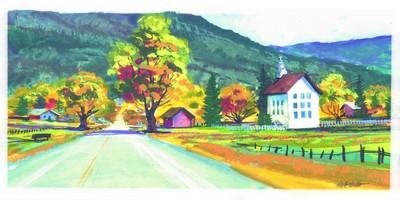Pine Valley a fine place for camping, recreation

Long a favorite with residents of Southern Utah, the beautiful Pine Valley area offers outstanding recreation and glimpses of its pioneer past. Visitors pass through the town of Pine Valley, a historic mountain village, on the way to the Pine Valley Recreation Area and access to the Pine Valley Mountain Wilderness, all within the confines of Dixie National Forest.
The Pine Valley Mountains create a forested island surrounded by desert in the southwestern corner of Utah. With the exception of a small campground on the eastern slopes of the mountains, most development concentrates on the western side in a valley where streams feed the Santa Clara River, which courses toward the Virgin River near St. George.
In 1984, some 50,000 acres of the area’s high country became part of the nation’s system of protected wilderness. A 60-mile network of hiking and equestrian trails explores the alpine region surrounding the 10,000-foot peaks of the mountain range. Other trails link up to expand the network outside the wilderness area for many more miles.
To reach Pine Valley from Las Vegas, drive north into Utah on Interstate 15. Exit on Bluff Street in St. George, 120 miles from Las Vegas. Turn left and watch for the junction with Highway 18, the road past Snow Canyon State Park to Central. Turn right to reach the hamlet of Pine Valley, located about 30 miles from St. George. The recreation area lies up the road a few miles from the little town.
The older streets of the village show off residences from yesteryear, sturdy Victorians constructed of mellow red brick with lacy touches of gingerbread. Today, the village extends well beyond the bounds of the early settlement, expanding with the influx of people to Southern Utah. The community depends on services available in larger towns nearby, but it offers a lodge and small cafe with three inside rooms and several cabins, a general store and a steakhouse open Friday and Saturday nights.
Settlers arrived in the little mountain valley in 1859, part of the Mormon colonization movement that settled hundreds of Western towns. It soon became a center for logging, timber milling and barrel-making. Pine Valley lumber helped build the developing communities in Southern Utah. Timber used for the enormous pipe organ built in Salt Lake City’s Tabernacle originated in Pine Valley.
Many of those early residents lie in the pioneer cemetery near the road from Central. Stop by for glimpses of the lives lived there on the frontier. So many children and women of child-bearing years died in those hard years. Humble headstones, ornate monuments and old-fashioned statuary reflect the times.
The handsome, white-painted Pine Valley Chapel remains the area’s architectural jewel. The oldest continually used Mormon chapel in Utah, this fine 1868 building provides a setting for Sunday services and welcomes guests in summer on guided tours daily from 11 a.m. to 5 p.m. The chapel was designed and constructed by Ebenezer Bryce, for whom Bryce Canyon was named. A shipbuilder by trade, the transplanted New Englander constructed the chapel of timber cut and milled in the valley. He reinforced the corners with cords of rawhide that contracted and hardened as they dried to keep the building squared. In the attic, visitors see the building’s resemblance to a ship built upside down.
Drive through the town to reach the scenic recreation area with its lush vegetation and rushing streams. Developments include camping and picnicking areas, a small reservoir and trails. Trails range from easy to very challenging. Trail maps available from the U.S. Forest Service in St. George help in planning.
The forest service maintains seven campgrounds in the area, including one for equestrians and two for large groups. Expect to pay a nightly fee of $11. Campers may reserve a few sites, but most remain available on a first-come basis. For best site selection, arrive early on weekends or visit mid-week.
Visitors who want to fish in Pine Valley must have a Utah license, available in stores and filling stations in the region. Anglers try for trout in the cold mountain streams tumbling down from the high country.
Margo Bartlett Pesek’s column appears on Sundays.